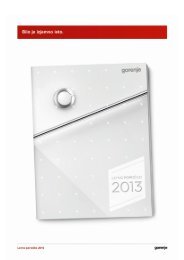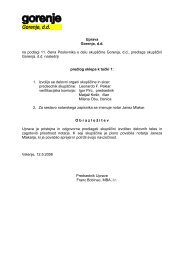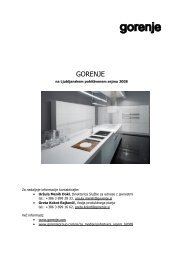Annual Report Gorenje Group 2009
Annual Report Gorenje Group 2009
Annual Report Gorenje Group 2009
You also want an ePaper? Increase the reach of your titles
YUMPU automatically turns print PDFs into web optimized ePapers that Google loves.
f) Investment property<br />
Investment property is property held either to earn rental income or for capital appreciation or for both,<br />
but not for sale in the ordinary course of business, use in the production or supply of goods or services<br />
or for administrative purposes. Investment property is measured at fair value (see note 4(iii)), with any<br />
change therein recognised in profit or loss.<br />
When the use of a property changes such that it is reclassified as property, plant and equipment, its fair<br />
value at the date of reclassification becomes its cost for subsequent accounting.<br />
g) Leased assets<br />
Leases in terms of which the <strong>Group</strong> assumes substantially all the risks and rewards of ownership are<br />
classified as finance leases. Upon initial recognition the leased asset is measured at an amount equal<br />
to the lower of its fair value and the present value of the minimum lease payments. Subsequent to<br />
initial recognition, the asset is accounted for in accordance with the accounting policy applicable to that<br />
asset.<br />
Other leases are operating leases. Leased assets are not recognised in the <strong>Group</strong>'s statement of<br />
financial position.<br />
h) Inventories<br />
Inventories are measured at the lower of cost and net realisable value. The cost of inventories is based<br />
on the weighted average price method, and includes expenditure incurred in acquiring the inventories,<br />
production or conversion costs and other costs incurred in bringing them to their existing location and<br />
condition. In the case of manufactured inventories and work in progress, cost includes an appropriate<br />
share of production overheads based on normal operating capacity.<br />
Net realisable value is the estimated selling price in the ordinary course of business, less the estimated<br />
costs of completion and selling expenses.<br />
i) Impairment<br />
(i) Financial assets<br />
A financial asset not carried at fair value through profit or loss is impaired if objective evidence<br />
indicates that a loss event has occurred after the initial recognition of the asset, and that the loss event<br />
had a negative effect on the estimated future cash flows of that asset that can be estimated reliably.<br />
Objective evidence that financial assets (including equity securities) are impaired can include default or<br />
delinquency by a debtor, restructuring of an amount due to the <strong>Group</strong> on terms that the <strong>Group</strong> would<br />
not consider otherwise, indications that a debtor or issuer will enter bankruptcy, the disappearance of<br />
an active market for a security. In addition, for an investment in an equity security, a significant or<br />
prolonged decline in its fair value below its cost is objective evidence of impairment. The <strong>Group</strong><br />
considers evidence of impairment for receivables and held-to-maturity investment securities at both a<br />
specific asset and collective level. All individually significant receivables and held-to-maturity<br />
investment securities are assessed for specific impairment. All individually significant receivables and<br />
held-to-maturity investment securities found not to be specifically impaired are then collectively<br />
assessed for any impairment that has been incurred but not yet identified. Receivables and held-tomaturity<br />
investment securities that are not individually significant are collectively assessed for<br />
impairment by grouping together receivables and held-to-maturity investment securities with similar risk<br />
characteristics.<br />
In assessing collective impairment the <strong>Group</strong> uses historical trends of the probability of default, timing<br />
of recoveries and the amount of loss incurred, adjusted for management's judgement as to whether<br />
105<br />
<strong>Annual</strong> <strong>Report</strong> <strong>Gorenje</strong> <strong>Group</strong> <strong>2009</strong>

















